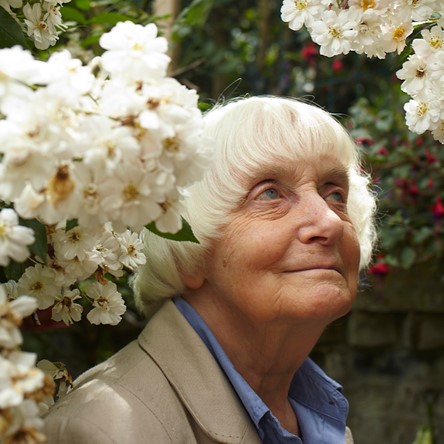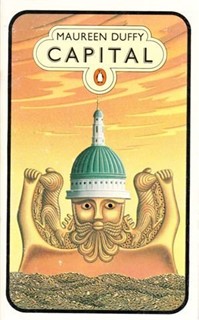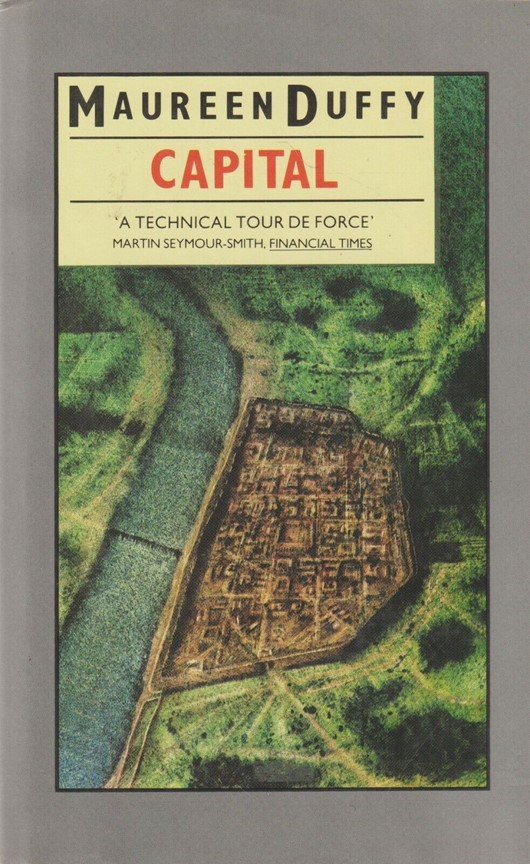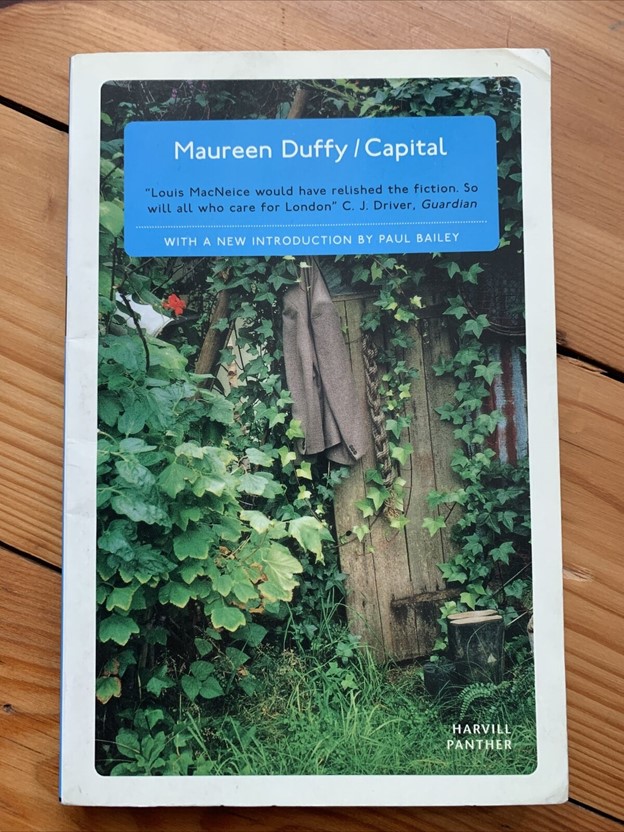Nicole Schrag

The city, this city. This concept or medium of civilization. Did it survive? Or did it collapse and the rats and rabbits nibble among the ruins of an unburied Pompeii, along with a few impoverished squatters? Or did it hold out, make terms with the barbarians, carry on, modifying itself in the process, maintaining a high degree of civilization? Was there in fact no break in continuity? (152)
Meepers, the protagonist of Maureen Duffy’s Capital, is himself a squatter, a veteran, an amateur archaeologist, and the holder of a self-conferred ‘London degree’ who is obsessed with the question of whether civilization will persist through what he perceives as an imminent economic disaster (96). The second instalment in Duffy’s London trilogy, Capital is a transitional fiction produced at a crucial moment of national instability on the cusp of Margaret Thatcher’s neoliberal transformation of the UK. Some scholars, including Sebastian Groes and Julian Wolfreys, frame their readings of Capital with an analysis of Duffy’s Londoners, An Elegy, which was published eight years later and is fully situated in the Thatcher era (Groes 29, Wolfreys 103). They argue that Capital manages to critique the heritage industry before it fully exists, to anticipate the increasing hardships facing working class Londoners, and to counter neoliberal ideology through shoring up alternative myths of the city. Although the impending entrenchment of Thatcher-era policies provides a valuable lens for the novel, Capital can also be read as following a line of inquiry parallel to Meepers’s sincere investigation into the question of whether a city’s civilization can persist through dark times. Duffy juxtaposes postmodern historical vignettes with a more realist story featuring London’s postwar housing shortage and imperial decline, fostering readers’ imaginations of both the past and the present and encouraging inventive responses to contemporary crises.

Capital has a convoluted structure that reveals Duffy’s affinity with the high modernism of James Joyce (to which she has spoken in multiple interviews) and that rivals Meepers’s own complex project. Between a brief prologue and epilogue, which take disorienting ten-thousand-foot views of Britain and London, respectively, the novel contains five sections, each titled with a different name for London (New Troy, Babylon, The City of the Dead, etc.). Across these sections, Duffy braids three narrative strands: a fictionalized history of London from the Stone Age to the present, told in a series of experimental vignettes; the third-person story of Meepers, who attempts to prove that ‘civilisation’ continued through London’s Iron Age and, less grandiosely, tries to find stable housing; and the epistolary, first-person account of an unnamed* historian, who becomes obsessed with Meepers’s project. Meepers and the historian’s lives grow intertwined as Meepers tries to make inroads in academia to validate his research and the historian transforms from a dismissive gatekeeper to a collaborator who helps him get access to a university computer that will read Meepers’s data and, hopefully, answer the question. The juxtaposition of ancient and contemporary issues is reflected in the Capital-related materials in the Duffy archive at King’s College London, which include news clippings from the early-to-mid-1970s about both archaeological discoveries and London’s housing problems. Duffy takes up these materials in her fiction to explore how the stories we tell ourselves about the distant past shape how we move through our own historical moments.
See this interactive map for an incomplete list of London sites in the three sections of the novel.
Meepers’s project takes up a question that, according to one of Duffy’s news clippings, archaeologists in the 1970s were asking – whether civilization in London continued through the Iron Age – but does so largely while seeking an answer to a more speculative line of inquiry: at a new moment of crisis, will civilization persist? (A similar question motivates much of Peter Ackroyd’s work, David Charnick argues.) An archaeologist who discovered artifacts dating from the Bronze Age at a WWII bomb site near St. Paul enthused, ‘What we should dearly love to find is evidence to prove continuous occupation of the site from the Bronze Age through to the Romans’ (Brian Hobley, quoted in Howard). As journalist Philip Howard noted, such a discovery would have significant ramifications for understanding the history of London: ‘if […] evidence of continuous occupation turn[s] up, we may conclude that London has been inhabited for up to five times as long as had previously been supposed’. While the researchers quoted in the article Duffy collected ruminate on how understandings of the city’s past may change, Meepers is equally concerned with the implications of such archaeological findings for the future: ‘it’s the same question with a gap of fifteen hundred or two thousand years between the asking. Does it survive?’ (152). He seeks validation of his ambitious project by the intellectual establishment, and he first tries to publish his work in an academic journal. When his speculative method is rejected out of hand by the historian, who is the journal editor, Meepers then tries to get access to institutional resources and credibility through the back door, by securing a position as a porter at Queen’s College, a fictionalized version of Duffy’s alma mater, King’s College London. Meepers and the real 1970s archaeologists share a sense of how monumental the discovery of continuous settlement would be, but Meepers’s turn from history to the unsettled present and unknown urban future makes his work discomfiting to the historian. He never attains the institutional prestige that might allow him to fully pursue his project yet persists in using his own limited resources to prove that urban humanity might endure.

The historical vignettes scattered throughout Capital give the reader a sense of what Meepers’s project might entail. Meepers has shrapnel in his head from combat, and the novel suggests that his head trauma causes him to hallucinate London’s dead as he goes about his everyday life. The vignettes employ anachronistic place names to make the layers of the city’s history visible to the reader: an early passage, for example, describes ‘Neanderthalensis’ as he searches from ‘Whitehall’ to ‘Acton height’ for a group that will help him survive the cold and hears ‘hyenas howling a few miles away on Hampstead Hill as they hunted through the night’ (29). The stories that (I surmise) Meepers tells do not aim for historical accuracy – though perhaps they do aim for a kind of geographical accuracy – but serve to emphasize connections across millennia of human experience. The inventive narratives, which include accounts of the Black Death told from the perspective of a flea, a transgender King Elizabeth, and a personified Moloch devouring bodies during the Great War, upend traditional histories to emphasize the affects – playfulness, horror, kindness, desire – that appear at moments of crisis. The stories underline historical contingencies, allowing both acknowledgement of dark times and hopefulness for the future. Sebastian Groes argues that perhaps both the historian and Meepers are overly invested in a linear history, but through presenting multiple forms of historical narrative, Duffy’s novel challenges the inevitability of historical progress or decline and cultivates imaginative approaches to both the past and the future (23).

Housing problems are visible signs of crisis in the contemporary sections of the novel, and the historian notes how London’s neighbourhoods are gentrifying, though his perspective is distanced and academic. When he journeys to Hammersmith to visit some students, he comments on the transformation of ‘terraces of handsome porticoed clerks’ houses’ to rental properties and then to ‘luxury flats or choice town houses for forty thousand quid’ (123). The historian finds himself vacillating between appreciation that ‘the houses look so much better’ and discomfort with the vague notion that ‘the people who used to live there I suppose are on a housing list somewhere, in temporary accommodation or gone out to the fringes of Slough’ (123). The distanced perspective on the cityscape resembles a columnist’s approach (in one of Duffy’s news articles) to describing the ‘danger that North Kensington may lose her most vital ingredient: the local mixture of economic groups which makes city life liveable for all concerned. The people who staff local services will be driven out. Portobello Road will go posh and creeping gentrification will clear the gaiety out of Ladbroke Grove’ (Jenkins, ‘The Men’ 21). While Jenkins has a more incisive critique and proposal for intentional planning that might preserve socioeconomic diversity in Central London, he shares with the historian a vantage point of distanced observation that neither the historian’s students – who lived in cramped shared accommodations – nor Meepers displays.
While the historian can observe the city’s upheavals with relative equanimity, Meepers’s housing problems repeatedly disrupt his intellectual quest. Also unlike the historian, he does not ruminate much on the larger social issues of which his experience is paradigm. Rather, urban housing problems are a matter of course for Meepers. He has been priced out of his family home, and, in the timeframe of the novel, lives in two sheds (one in the shared private gardens outside said childhood home, another in Kensington Gardens) and in an empty skyscraper modelled on the infamous Centre Point development, which was completed in 1966 but remained empty for nearly ten years due to the owner being unwilling to lower the asking rent. Sneaking out at dawn and in at dusk are Meepers’s routine, as are displacement and brainstorming new housing possibilities. These sections’ pragmatic perspective contrasts sharply with the distant analysis of both the historian and the Capital archive’s newspaper articles about squatting, Centre Point, and the lack of basic plumbing in a shockingly high number of London residences. (Some of the historian’s poor and savvy students, in fact, use their knowledge of news media conventions for reporting on squatters to stage a demonstration providing cover for Meepers when he is about to get arrested.) Duffy’s depiction of homelessness goes beyond the statistics from the papers to convey the indignities Meepers experiences due to his being unhoused. He most notably suffers a lack of medical care: he won’t go to hospital despite significant injuries sustained in a mugging because he doesn’t have a permanent address, and his roughed-up appearance makes him suspicious to most strangers, including the police. Whether trying to secure an audience for his research or pursuing archaeological leads, Meepers struggles with obstacles made more arduous by his being unhoused. Duffy’s writing contrasts with her clippings’ sympathetic but distant tone when addressing the massive social and economic problems in the capital. Instead, her textured descriptions of Meepers’s everyday life give weight to the tragedy of his stymied intellectual project.

In an ironic twist, Duffy reveals that the historian resides in the house next door to Meepers’s childhood home, and the two characters’ final encounter marks the beginning of a reconciliation cut short by Meepers’s untimely death. After an accident at a building site where he was doing some unpermitted archaeological work, Meepers is picked up by the police and gives the historian’s address as his own. Having just discovered a pottery fragment suggesting that there was indeed civilisational continuity in London from the Bronze Age to the Roman era, a bedraggled Meepers is welcomed in by the surprised historian and feverishly sets to work to complete his thesis. Injured and exhausted, he hallucinates visions of the city’s dead: ‘They were pushing up through the ground, standing on each other’s shoulders and calling to him not to leave them out as if he was their last hope of immortality. […] He couldn’t keep track of it all. He had failed and they knew that he had’ (213). As Meepers faces the impossibility of recording these undocumented lives that have haunted him throughout the novel, he reaffirms their dignity and laments the stories he has missed. Ultimately, Meepers dies of a heart attack before the computer analyses his work, and readers never learn the results. Duffy instead raises questions about the production of academic knowledge by juxtaposing post-Fordist computerized objectivity with a personal, inventive vision of London. Capital uses Meepers’s unconventional research and early computer technologies to destabilize the status quo, making the work of the historian appear ready for reform.
In addition to the three braided narratives addressed above, Capital also contains a dystopian prologue and post-apocalyptic epilogue that capture the indeterminacy of the city’s future civilization. The two-page epilogue describes a helicopter pilot and photographer as they observe the now-dangerous city from above. London has lost most of its advanced technology, and its aggressively isolationist people ward off the aircraft with rudimentary weapons (221). Although London must have experienced a catastrophic event to reach this point, the pilot mentions that the city welcomes new immigrants, as long as they can prove they are refugees. The ambivalent concluding passage, which suggests that ‘civilization’, depending on how one might define it, has both continued and been disrupted, concludes with the phrase, ‘Or Hierusalem…’ This Latin spelling of Jerusalem, evokes a utopic city and yet avoids directly referencing Blake’s Jerusalem hymn. As another name for London, Hierusalem could function as an additional section title within the book, and the ellipsis that follows it suggest a future that is not yet finished, despite the city’s apparent devastation. The spare but potentially hopeful details of this passage indicate that although this period, like the Iron Age, may not be thoroughly documented, it features ‘civilized’ elements.
Duffy responds to a time of crisis by blending literary methods and history, not to set a specific programme for social change (though she is a prominent activist in other contexts) so much as to create a space in which to reimagine the possibilities of change. In contrast to the bleak prologue, the novel concludes with a hopeful ambivalence about the future. Duffy draws attention to social, cultural, and political crises of the mid-1970s to demonstrate the gravity of contemporary problems precipitated, one of her news articles says, by disinvestment in public goods and economic instability (Thomas 21). There are no simple solutions to these social problems, but re-narrating the past is offered as a resource for thinking through new possibilities for the future. As Christina Wick Sizemore’s study of Duffy’s fiction concludes, ‘For those like Meepers . . . who have learned to see the city as an archaeological dig with layers of past that are worth preserving and a varied present that is worth celebrating, London can be the new Jerusalem’ (233). Although Duffy recognizes many of the phenomena that ended up leading to Thatcherism, in this novel, such a future had not quite been determined yet; given that future, the past nevertheless offers resources of hope.
Capital is Maureen Duffy’s most-studied work and likely her most-read novel (if Goodreads is any indication). Yet Maureen Duffy’s impressive body of imaginative writing spans multiple genres and periods and includes several London fictions. Her first, autobiographical novel, That’s How it Was (1962), reflects how Duffy’s mother encouraged her education as an avenue out of working-class London life and, significantly, made Duffy one of the first publicly out British lesbian writers. Many of her other works take the metropolis as a key setting, including Microcosm (1966), a novel centred around gay subcultures, and the other instalments of the London trilogy: Wounds (1969) and Londoners (1983). She is best known for her earlier work, but she continues as a nonagenarian to produce literary work that spans an impressive range of content and forms. Her legacy also includes her advocacy for authors’ rights to their work, especially through the public lending right in the UK. It is this writer’s opinion that Duffy is an egregiously underappreciated writer. Her generically diverse, large corpus, both modernist and postmodern, offers much of literary and historical interest to the reader of city fictions.
*Some promotional materials for the book mistakenly call the historian Mr. Emory, which is the name of the head porter at Queen’s College.
References:
Charnick, David. ‘Peter Ackroyd: The Plato Papers (1999)’. Literary London Society, http://literarylondon.org/london-fictions/ackroyd-plato-papers-1999/.
Groes, Sebastian. The Making of London: London in Contemporary Literature. London: Palgrave Macmillan, 2011. Kindle edition.
Thomas, Harford. ‘Reasons Why Living Beyond Our Means Should Be this Budget’s Centrepoint’. The Guardian, 13 Mar. 1974, p. 21. DUFFY, Maureen Patricia (b. 1933), GB0100 KCLCA K/PP56, Box 112 Capital Research. Kings College London Archives, London.
Howard, Philip. ‘Evidence of Settlement in London Before the Romans’;. The Times, 1 Oct. 1975, p. 1. DUFFY, Maureen Patricia (b. 1933), GB0100 KCLCA K/PP56, Box 112 Capital Research. Kings College London Archives, London.
Jenkins, Simon. ‘Is Harry Hyams Really Too Big to Handle?; Evening Standard, 16 Jan. 1973, p. 17. DUFFY, Maureen Patricia (b. 1933), GB0100 KCLCA K/PP56, Box 112 Capital Research. Kings College London Archives, London.
Jenkins, Simon. ‘The Men Who Lost a Fortune Building Palaces’. Evening Standard, 27 Feb. 1973, p. 21. DUFFY, Maureen Patricia (b. 1933), GB0100 KCLCA K/PP56, Box 112 Capital Research. Kings College London Archives, London.
Wick Sizemore, Christina. A Female Vision of the City: London in the Novels of Five British Women. Knoxville: University of Tennessee Press, 1989.
Wilcox, David. ‘Scandal of Homes that Do Without’. Evening Standard, 4 April 1973, front page. DUFFY, Maureen Patricia (b. 1933), GB0100 KCLCA K/PP56, Box 112 Capital Research. Kings College London Archives, London.
Wolfreys, Julian. Writing London: Volume 2: Materiality, Memory, Spectrality. New York: Palgrave Macmillan, 2004.
Further Reading:
‘B.S Johnson and Maureen Duffy: Aspiring Writers: A Conversation with Maureen Duffy’. Melanie Seddon. Writers in Conversation, vol. 2, no. 1, Feb. 2015, http://fhrc.flinders.edu.au/writers_in_conversation/.
Duffy, Maureen. Londoners. 1983.
Duffy, Maureen. Microcosm. 1966.
Duffy, Maureen. That’s How it Was. 1962.
Duffy, Maureen. Wounds. 1969.
Lees, Clare A. ‘Kings, and Queens, Histories in Fact and Fiction’. Strandlines Maureen Duffy Special Feature, edited by Fran Allfrey and Katie Webb, Nov. 2020, https://www.strandlines.london/series/maureen-duffy/maureen-duffy-at-80/duffy-and-kings/kings-and-queens-fact-and-fiction/.
Wick Sizemore, Christina. A Female Vision of the City: London in the Novels of Five British Women. Knoxville: University of Tennessee Press, 1989.
